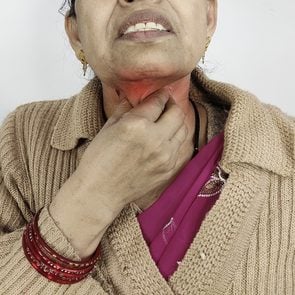If You’ve Got Mice, This Story Will Convince You to Call the Exterminator

A rare disease transmitted by the microscopic mites that live on mice turned one woman's life upside-down.
Esther (last name withheld by request) couldn’t afford to be sick, let alone contagious. In 2021, the then 46-year-old was running a licensed daycare out of her house in the Bronx. She also had five children of her own, ages 12 to 19, to keep safe. But on a trip to South Carolina for her eldest son’s graduation in late June, she started feeling unusually weak. “I was walking around for a few hours and it was hot so I thought maybe I was just tired,” Esther says.
A few weeks and several negative COVID tests later, Esther still wasn’t feeling better. She had no energy, felt slightly feverish and was short of breath. But taking time off to see a doctor was out of the question; whatever it was, she would no longer be contagious, and too many other parents depended on her for child care. So she waited, hoping the symptoms would disappear on their own.
By August, though, the lymph nodes under her armpits had become swollen, and her head ached constantly. She also developed an eschar (a button-like sore with a black, scabby centre) on her right flank. At first, she thought it was just a pimple or a boil, but within a week, it was accompanied by a red rash. Esther headed to the emergency room at the nearby Montefiore Hospital.
Doctors examined the abscess—which can be caused by everything from burns to bedsores—and gave Esther antibiotics to prevent infection. They told her to take acetaminophen for any pain and then sent her home.
A turn for the worse
Over the next two days, her symptoms worsened. A spotty, pustular rash appeared on her forehead, chin and cheeks, then spread across the rest of her body. She had a debilitating headache, neck pain, fever and chills, and she couldn’t eat. “I thought maybe it was chicken pox, but I had that when I was a child,” she says. “I was laid down flat. I couldn’t take a shower because I was shivering so much, and I could barely walk from the bedroom to the living room.” Her assistant took over running the daycare, and her husband brought her back to the hospital.
This time she wasn’t sent home. Instead, infectious disease doctors were called in, and the information gathering began.
Esther was born in Ghana but had lived in the United States for 14 years. She had no known allergies, was up to date on her vaccinations, no one else in her family was sick and, other than her trip to South Carolina, she hadn’t travelled anywhere. Previous medical conditions included asthma, occasional migraines and chronic hepatitis B, but otherwise she was healthy. She didn’t have any pets but informed the doctors that she did occasionally have mice in her home, although she always called an exterminator at the first sign of them.
A lumbar puncture (which involves inserting a needle between two vertebrae to remove a fluid sample) ruled out meningitis. A nasal swab that can detect the flu, whooping cough and bacterial pneumonia also came back negative, and she didn’t have COVID-19, West Nile, HIV or hepatitis C. The doctors had no idea what was causing her symptoms. “I didn’t know what was happening to me, and it was scary,” Esther says.
Honing in on a diagnosis
Because of her rash, fever and persistent headache, the infectious disease team considered Rocky Mountain spotted fever or, more likely because Esther had mentioned a mouse problem, rickettsialpox, which is transmitted by mites that live on mice. Either way, they immediately started her on a seven-day course of doxycycline, a broad-spectrum antibiotic used to treat a range of bacterial infections, including tick-borne illnesses and anthrax.
Rocky Mountain spotted fever has a high mortality rate, so whenever doctors suspect it, they treat it right away, as it can only be confirmed months later with an antibody test, according to Dr. Carissa Windish, who was part of the infectious disease team investigating Esther’s case. The disease is a tick-borne illness, and symptoms include fever, chills, headache and sometimes, but not always, a rash. Untreated, the death rate is up to 80 per cent. Rocky Mountain spotted fever is usually associated with recent travel, but as part of her research, Windish discovered that it had originated in the Bronx in previous cases.
Although the symptoms are similar, rickettsialpox is much more benign and, while unpleasant, will usually resolve on its own in a matter of weeks. The disease was first discovered in New York but is found throughout the world, Windish says. It’s named for the bacteria that causes it (Rickettsia akari), and because the first cluster of cases, which were identified in 1946, were originally misdiagnosed as atypical chicken pox.

A full recovery—from rickettsialpox
Doxycycline is the treatment for both Rocky Mountain spotted fever and rickettsialpox, and within two days of taking the antibiotic, Esther’s fever disappeared, along with her rash. But she still had no idea what had made her so sick. “Sometimes when we use doxycycline to treat a mystery illness, we never find out what was causing the symptoms,” Windish says.
Esther was discharged, although it took a month before she made a full recovery. “I was still so weak, but I had to work,” she says. “After the parents picked up their children, I would just sit in a chair for three or four hours.”
Then, six months later, Windish’s team confirmed the diagnosis of rickettsialpox. Esther was relieved, and grateful. “I am feeling good,” she says. “And I’m happy to say we don’t have mice in the house anymore.”
Next, check out 20 symptoms you should never ignore.







